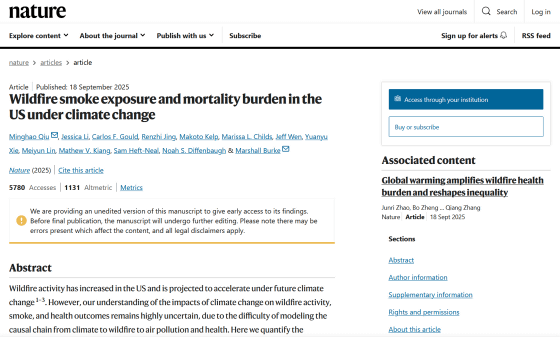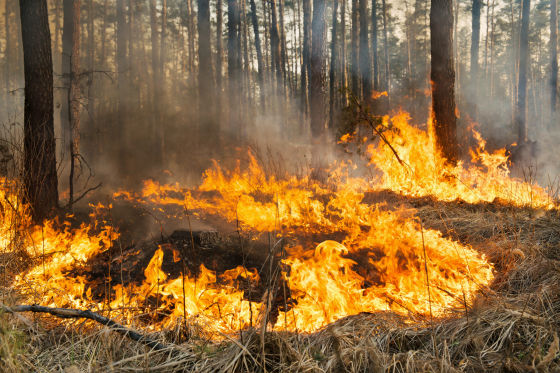Climate change could cause wildfire smoke deaths in the US to reach 70,000 per year by 2050

In recent years, large-scale wildfires have occurred frequently in the United States and Australia. In 2025,
Wildfire smoke exposure and mortality burden in the US under climate change | Nature
https://www.nature.com/articles/s41586-025-09611-w

US faces rising death toll from wildfire smoke, study finds | Stanford Doerr School of Sustainability
https://sustainability.stanford.edu/news/us-faces-rising-death-toll-wildfire-smoke-study-finds
Wildfire-smoke-related deaths in the US could climb to 70,000 per year by 2050 due to climate change, study finds | Live Science
https://www.livescience.com/health/viruses-infections-disease/wildfire-smoke-related-deaths-in-the-us-could-climb-to-70-000-per-year-by-2050-due-to-climate-change-study-finds
In recent years, wildfires have become more frequent and severe. This is thought to be due to a decrease in soil moisture caused by rising temperatures due to global warming, which has led to drier vegetation and increased flammability. Furthermore, once a wildfire breaks out, the dry vegetation combined with warmer air encourages the fire to spread, making it more difficult to extinguish. Furthermore, an increase in wildfires creates a feedback loop in which greenhouse gases emitted by the burning of organic matter accelerate global warming and cause further wildfires.
Wildfires not only burn homes and destroy forests, but also pose a health risk by releasing pollutants such as fine particles and soot. These particles, known as PM2.5 fine particulate matter, are about 1/28 the size of a human hair and can lodge in the mucous membranes of the mouth, nose, and eyes, causing short-term irritation, coughing, burning, and worsening skin conditions.
Furthermore, inhaling PM2.5 into the lungs can worsen existing respiratory diseases such as asthma and chronic obstructive pulmonary disease (COPD) , and when PM2.5 enters the bloodstream, it can irritate the heart, increasing the risk of heart attack and coronary artery disease. Wildfires expose many people to pollutants for days or weeks, increasing the number of deaths beyond those directly affected.

To calculate the human and economic costs of exposure to wildfire smoke, a research team from Stanford University, the State University of New York at Stony Brook, and other institutions analyzed county-level death records across the United States from 2006 to 2019. They then combined these records with ground-based measurements of smoke emissions and winds and used machine learning to model the movement of PM2.5 produced by wildfires across North America.
The researchers then correlated changes in smoke concentrations with historical fluctuations in mortality rates and used a global climate model to project future wildfire activity, smoke emissions, and health impacts under different warming scenarios up to 2050.
The study found that the number of deaths due to wildfire smoke in the United States will reach 41,380 per year from 2011 to 2020. Under the current global warming scenario, in which global temperatures rise by 2 degrees Celsius above pre-industrial levels, the number of deaths due to wildfire smoke could increase by more than 70% by 2050, reaching 71,420 per year.
California is projected to experience the greatest increase in wildfire smoke-related deaths, with an estimated 5,060 additional deaths per year by 2050. New York will be next with 1,810 deaths per year, followed by Washington with 1,730 deaths per year, Texas with 1,700 deaths per year, and Pennsylvania with 1,600 deaths per year.
Furthermore, the researchers estimated that wildfire smoke-related deaths under current global warming scenarios could cost as much as $608 billion annually by 2050. This estimated loss exceeds the total estimated losses from other climate-change-related damages, including agricultural losses, storm damage, and temperature-related deaths.

'What we're seeing is a nationwide increase in wildfire smoke, consistent with other studies,' said Minghao Qiu, lead author of the paper and assistant professor at the State University of New York at Stony Brook. 'While the increase is more pronounced on the West Coast, we're also seeing long-distance transport of wildfire smoke across the U.S., including large smoke events in the East and Midwest due to fires in Canada.'
'It's widely recognized that wildfire activity and smoke exposure are rapidly changing. Unfortunately, this has been the experience of people on the West Coast over the past decade and those on the East Coast over the past few years,' said Marshall Burke, a co-author of the paper and professor of environmental social sciences at Stanford University. 'People across the U.S., including pregnant women, children, and asthma sufferers, will be affected by wildfire smoke.'
Related Posts:
in Free Member, Science, Posted by log1h_ik







